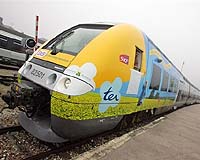| . |  |
. |
Tel Aviv, Israel (SPX) Jul 28, 2010 Thousands of people around the world have died in train wrecks caused by natural disasters. In 2004, the tsunami in Southeast Asia derailed a Sri Lankan train, killing 1,700 people. But with modern advances, these tragedies can be avoided - and a Tel Aviv University researcher, working in collaboration with teams from seven countries, is leading the way. Prof. Lev V. Eppelbaum of Tel Aviv University's Department of Geophysics and Planetary Sciences and his colleagues are collecting high-tech sensing data from satellites, airplanes, magnetic and soil sensors, and unmanned aircraft to devise a solution that will provide a reliable early-warning system for train operators. It's all part of the European Project FP7 research, "Integrated System for Transport Infrastructures Surveillance and Monitoring by Electromagnetic Sensing," which includes participants from Israel, Italy, France, Sweden, Norway, Switzerland and Romania. The international team of researchers aims to connect emerging technologies so that train accidents caused by avalanches, earthquakes and even terrorists can be avoided.
A system to detect sabotage "We are creating a new interpretation system - allowing us to integrate cutting-edge technologies from across Europe," he says, adding that the biggest challenge, right now, is eliminating background "noise" from the data being collected. Climatic features and parameters such as soil types and physical geography can be very different from one region to another, which makes the work even more of a challenge. Some of Prof. Eppelbaum's recent research advances have been reported in the Zeitschrift fur Geomorphologie, the Journal of Arid Environments and the Proceedings of the SAGEEP Conference (USA).
On the right Amtrak Prof. Eppelbaum expects their methods will be adopted by the world's railway systems. As the cost of fuel for cars and planes rises, and environmentally-friendly train travel is more heavily promoted, experts predict that more Americans will be riding the rails to work and between cities. In 2008, about 30 million passengers rode on Amtrak trains, and train ridership figures have been steadily increasing. At present, there is no monitoring system for either natural disasters or terror attacks on rail systems in America or anywhere else. Prof. Eppelbaum says he has his work cut out for him: putting together different geophysical measurements and formats of sensors, he is collecting very different kinds of data and trying to turn it into usable information. "It's complicated math and physics," says Prof. Eppelbaum. "And yes, it includes lots of scribbling and equations on the chalkboard."
Share This Article With Planet Earth
Related Links Tel Aviv University Great Train Journey's of the 21st Century
 China orders 40 Bombardier high speed trains
China orders 40 Bombardier high speed trainsMontreal (AFP) July 16, 2010 A Chinese joint venture with Canadian manufacturer Bombardier has received an order for 40 CRH1 high speed trainsets from the Chinese transportation ministry, the company announced Friday. The value of the sale for joint venture Bombardier Sifang is 761 million dollars. Bombardier's share is 373 million dollars, it said. Each of the trainsets, consisting of eight cars, can carry a total ... read more |
|
| The content herein, unless otherwise known to be public domain, are Copyright 1995-2010 - SpaceDaily. AFP and UPI Wire Stories are copyright Agence France-Presse and United Press International. ESA Portal Reports are copyright European Space Agency. All NASA sourced material is public domain. Additional copyrights may apply in whole or part to other bona fide parties. Advertising does not imply endorsement,agreement or approval of any opinions, statements or information provided by SpaceDaily on any Web page published or hosted by SpaceDaily. Privacy Statement |